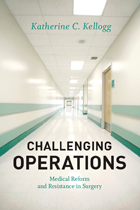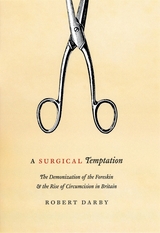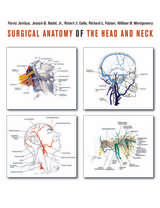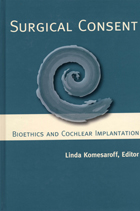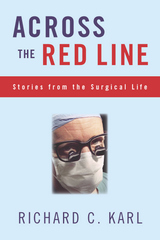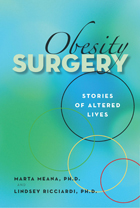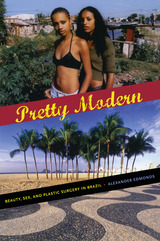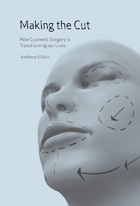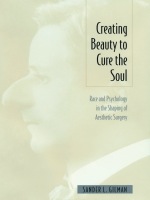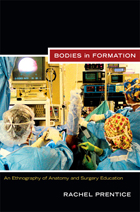Surgeries & OperationsCollection by Cassandra Verhaegen (11 items)Learning about surgery's 'not brain surgery!' Includes the following tags:
21st Century, Across, Anatomy, Atlases, Beauty, Beauty & Grooming, Beauty, Personal, Bioethics, Bodies, Britain, Cosmetic & Reconstructive, Cure, Cut, Deaf, Deaf children, Deafness, Diet & Nutrition, Effect of technological innovations on, Elliott, Anthony, Ethnography, Formation, Head, Health & Fitness, Hospitals, Hours of labor, Making, Medical, Medical staff, Obesity, Patients, Rehabilitation, Resistance, Shaping, Soul, Surgeons, Surgery, Weight Loss
See More
|
Challenging Operations
by Katherine C. Kellogg
University of Chicago Press, 2011
In 2003, in the face of errors and accidents caused by medical and surgical trainees, the American Council of Graduate Medical Education mandated a reduction in resident work hours to eighty per week. Over the course of two and a half years spent observing residents and staff surgeons trying to implement this new regulation, Katherine C. Kellogg discovered that resistance to it was both strong and successful—in fact, two of the three hospitals she studied failed to make the change. Challenging Operations takes up the apparent paradox of medical professionals resisting reforms designed to help them and their patients. Through vivid anecdotes, interviews, and incisive observation and analysis, Kellogg shows the complex ways that institutional reforms spark resistance when they challenge long-standing beliefs, roles, and systems of authority.
1
|
A Surgical Temptation
by Robert Darby
University of Chicago Press, 2005
In the eighteenth century, the Western world viewed circumcision as an embarrassing disfigurement peculiar to Jews. A century later, British doctors urged parents to circumcise their sons as a routine precaution against every imaginable sexual dysfunction, from syphilis and phimosis to masturbation and bed-wetting. Thirty years later the procedure again came under hostile scrutiny, culminating in its disappearance during the 1960s. Why Britain adopted a practice it had traditionally abhorred and then abandoned it after only two generations is the subject of A Surgical Temptation. Robert Darby reveals that circumcision has always been related to the question of how to control male sexuality. This study explores the process by which the male genitals, and the foreskin especially, were pathologized, while offering glimpses into the lives of such figures as James Boswell, John Maynard Keynes, and W. H. Auden. Examining the development of knowledge about genital anatomy, concepts of health, sexual morality, the rise of the medical profession, and the nature of disease, Darby shows how these factors transformed attitudes toward the male body and its management and played a vital role in the emergence of modern medicine.
2
|
Surgical Anatomy of the Head and Neck
edited by Parviz Janfaza M.D., Joseph B. Nadol Jr., M.D., Robert J. Galla M.S.I., Richard L. Fabian M.D. and William W. Montgomery M.D.
contributions by Gregory W. Randolph Randolph M.D., Peter A.D Rubin M.D., Salah D. Salman M.D., Mark A. Varvares M.D, Nathalie Azar M.D., Mark L. Cheney M.D., Ivo P. Janecka M.D. and Michael J. McKenna M.D. Harvard University Press, 2001
Surgical Anatomy of the Head and Neck was immediately hailed as indispensable when it was first published in 2001. In demand ever since, this classic surgical atlas—packed with more than 700 exceptional drawings, 537 of them in full color, by an internationally noted medical illustrator—is now available again, with an extensive new index, after years of being out of print.
3
|
Surgical Consent
edited by Linda Komesaroff
Gallaudet University Press, 2007
With the rate of cochlear implantation reaching 80% to 90% of all deaf children, some as young as five months old, Surgical Consent: Bioethics and Cochlear Implantation arrives at a critical juncture. This comprehensive collection features essays by Priscilla Alderson, Inger Lise Skog Hansen, Hilde Haualand, volume editor Linda Komesaroff, Paddy Ladd, Harlan Lane, Karen Lloyd, Eithne Mills, Paal Richard Peterson, Gunilla Preisler, Kristina Svartholm, and Michael Uniacke. These worldwide renowned ethicists, educators, and Deaf leaders express their diverse perspectives on the bioethics of childhood cochlear implantation according to their discipline and a number of themes of inquiry: human rights, medical and social ethics, psychology, education, globalization, identity, life pathways, democracy, media, law, and biotechnology.
4
|
Across The Red Line
by Richard Karl
Temple University Press, 2003
Richard Karl, a doctor and teacher, takes the reader closer than any writer before into the corridors of the hospital, on the surgical table, and into the world of medicine. In these pages we see the tragedies and triumphs of modern medicine: the beauty of surgery done well, and the aftermath of operations that fail to deliver on the hopes of the doctor and patient. We witness the "M&M"—the morbidity and mortality meeting—where doctors scrutinize their own work and mistakes, and the often inevitable outcomes of treatment. Suffused throughout are Karl’s keen observations on the workings of the human body and its immense capacity for healing. "...I celebrate the rich privilege accorded the practicing surgeon. The surgical life is really about bearing witness to the human condition and about respecting the many almost whimsical variations of biology and about the intersection of the two. It is remarkable, really, the way I get to know people so intimately so quickly, and to observe the brave and often noble behavior in them, while I witness the relentless push of biology, the aging and decay, the growth and development, but most especially the healing, both physical and emotional. It is this natural drive of our bodies to repair themselves from all injuries (including the surgeon's wounds) that is the centerpiece of medicine. Without it no surgeon could cut." Written with economy and subtlety, Across the Red Line offers a vivid picture of disease and the miracle of life. It will interest anyone who's ever been on either side of the surgical table.
5
|
Obesity Surgery
by Marta Meana and Lindsey Ricciardi
University of Nevada Press, 2008
Obesity is a major national health problem, and science has been developing a number of ways to address it. The most revolutionary is surgical intervention to alter the gastrointestinal system so that less food/nutrients can be consumed and/or absorbed. People who undergo this surgery usually experience drastic weight loss and dramatic health improvements. They also discover a new sense of self and face challenges often unimaginable when they were obese.
Using in-depth, first person accounts of 33 men and women who underwent weight-loss surgery, this book elaborates on the complexities of finally getting what you wished for— the good, the bad, and the totally unexpected.
We live in a culture fascinated by physical make-overs, but no one talks about their psychological consequences. Losing a lot of weight is perhaps the most extreme make-over of all. It leaves people emotionally changed, and these changes are the heart of this book.The fascinating narratives contain important lessons for individuals considering or having had the surgery and for those who try to help them. It is simply a story of how finally getting what you’ve always wished for can be much more complicated affair than you ever imagined.
6
|
Pretty Modern
by Alexander Edmonds
Duke University Press, 2010
Pretty Modern is a riveting account of Brazil’s emergence as a global leader in plastic surgery. Intrigued by a Carnaval parade that mysteriously paid homage to a Rio de Janeiro plastic surgeon, anthropologist Alexander Edmonds conducted research that took him from Ipanema socialite circles to glitzy telenovela studios to the packed waiting rooms of public hospitals offering free cosmetic surgery. The result is provocative exploration of the erotic, commercial, and intimate aspects of beauty in a nation with extremes of wealth and poverty and a reputation for natural sensuality. Drawing on conversations with maids and their elite mistresses, divorced housewives, black celebrities, and favela residents aspiring to be fashion models, Edmonds analyzes what sexual desirability means and does for women in different social positions. He argues that beauty is a distinct realm of modern experience that does not simply reflect other inequalities. It mimics the ambiguous emancipatory potential of capital, challenging traditional hierarchies while luring consumers into a sexual culture that reduces the body to the brute biological criteria of attractiveness. Illustrated with color photographs, Pretty Modern offers a fresh theoretical perspective on the significance of female beauty in consumer capitalism.
7
|
Making the Cut
by Anthony Elliott
Reaktion Books, 2008
From London to New York, Madrid to Melbourne, Singapore to Tehran, the demand for cosmetic surgery is soaring. Botox injections, collagen fillers, breast implants, microdermabrasion, mini face-lifts: extreme reinvention is all the rage. For better or worse, ours is the era of cosmetic surgical culture.
In this captivating book, which draws upon research conducted in Europe, America and Australasia, social commentator Anthony Elliott investigates the rise and rise of cosmetic surgery, lucidly reviewing recent developments in celebrity culture and the consumer industries, which many argue are responsible for the popularity of cosmetic and surgical forms of extreme reinvention. Yet it is not just cultural forces advancing the makeover industries: Elliott shows that cosmetic surgical culture has become increasingly global in our own time as a result of major institutional changes dominating public life in Western societies. He provocatively argues that personal vulnerabilities have reached the point where people turn to surgical culture in an effort to reinvent themselves and improve their life prospects
Making the Cut paints a disturbing social portrait of a global culture held in thrall to immediacy, where cosmetic surgical enhancements of the body are fundamental to new forms of self-design and self-improvement.
8
|
Invasion of the Body
by Nicholas L. Tilney
Harvard University Press, 2011
In 1913, the Peter Bent Brigham Hospital in Boston admitted its first patient, Mary Agnes Turner, who suffered from varicose veins in her legs. The surgical treatment she received, under ether anesthesia, was the most advanced available at the time. At the same hospital fifty years later, Nicholas Tilney—then a second-year resident—assisted in the repair of a large aortic aneurysm. The cutting-edge diagnostic tools he used to evaluate the patient’s condition would soon be eclipsed by yet more sophisticated apparatus, including minimally invasive approaches and state-of-the-art imaging technology, which Tilney would draw on in pioneering organ transplant surgery and becoming one of its most distinguished practitioners.
9
|
Creating Beauty To Cure the Soul
by Sander L Gilman
Duke University Press, 1998
Why do physicians who’ve taken the Hippocratic Oath willingly cut into seemingly healthy patients? How do you measure the success of surgery aimed at making someone happier by altering his or her body? Sander L. Gilman explores such questions in Creating Beauty to Cure the Soul, a cultural history of the connections between beauty of body and happiness of mind. Following these themes through an impressive range of historical moments and players, Gilman traces how aesthetic alterations of the body have been used to “cure” dissatisfied states of mind. In his exploration of the striking parallels between the development of cosmetic surgery and the field of psychiatry, Gilman entertains an array of philosophical and psychological questions that underlie the more practical decisions rountinely made by doctors and potential patients considering these types of surgery. While surveying and incorporating the relevant theories of Sigmund Freud, Alfred Adler, Karl Menninger, Paul Schilder, contemporary feminist critics, and others, Gilman considers the highly unstable nature of cultural notions of health, happiness, and beauty. He reveals how ideas of race and gender structured early understandings of aesthetic surgery in discussions of both the “abnormality” of the Jewish nose and the historical requirement that healthy and virtuous females look “normal,” thereby enabling them to achieve invisibility. Reflecting upon historically widespread prejudices, Gilman describes the persecutions, harrassment, attacks, and even murders that continue to result from bodily difference and he encourages readers to question the cultural assumptions that underlie the increasing acceptability of this surgical form of psychotherapy. Synthesizing a vast body of related literature and containing a comprehensive bibliography, Creating Beauty to Cure the Soul will appeal to a broad audience, including those interested in the histories of medicine and psychiatry, and in philosophy, cultural studies, Jewish cultural studies, and race and ethnicity.
10
|
Bodies in Formation
by Rachel Prentice
Duke University Press, 2012
Surgeons employ craft, cunning, and technology to open, observe, and repair patient bodies. In Bodies in Formation, anthropologist Rachel Prentice enters surgical suites increasingly packed with new medical technologies to explore how surgeons are made in the early twenty-first century. Prentice argues that medical students and residents learn through practice, coming to embody unique ways of perceiving, acting, and being. Drawing on ethnographic observation in anatomy laboratories, operating rooms, and technology design groups, she shows how trainees become physicians through interactions with colleagues and patients, technologies and pathologies, bodies and persons. Bodies in Formation foregrounds the technical, ethical, and affective formation of physicians, demonstrating how, even within a world of North American biomedicine increasingly dominated by technologies for remote interventions and computerized teaching, good care remains the art of human healing.
11
|
| Click here to go to the beginning. | |||||||||||
